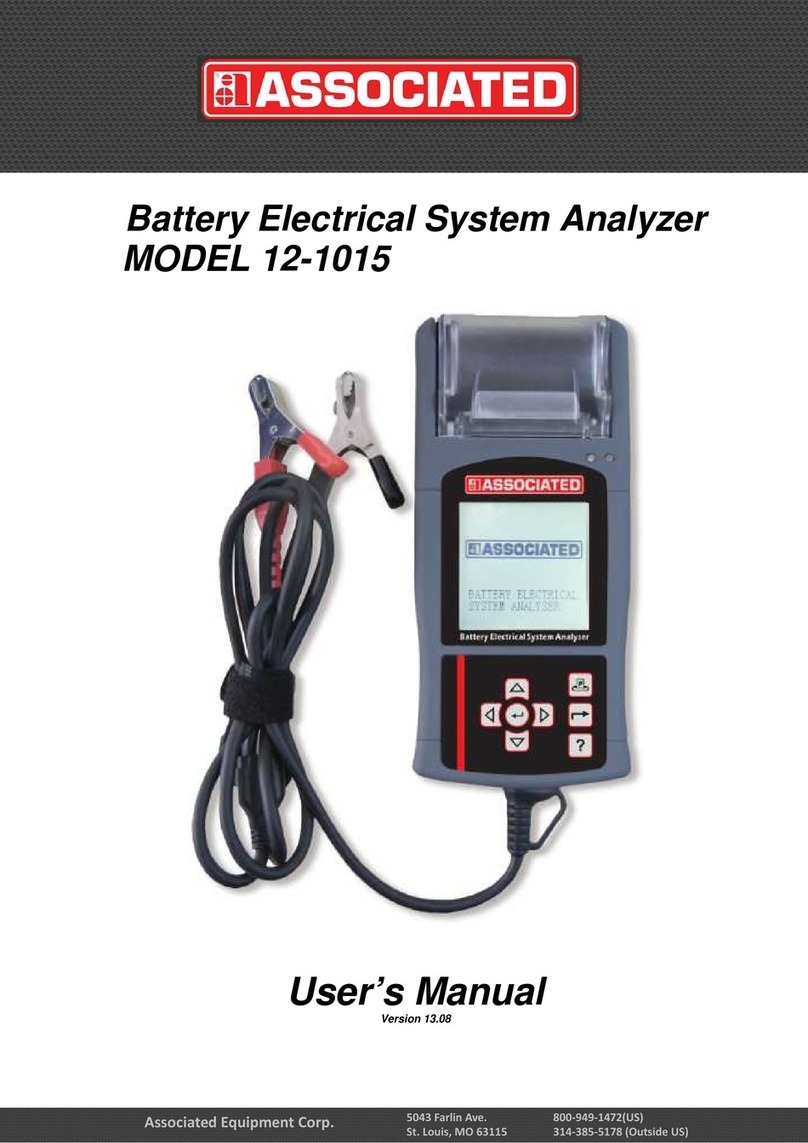
_______________________________________________________________________________
Model 12-1012 Users’ Manual Version 13.08
Associated Equipment Corp.
5043 Farlin Ave. 800-949-147 (US)
Table of Contents
1.0 Introduction------------------------------------------------------------------------------------------
1.1 The Product-------------------------------------------------------------------------------------------------------3
1.2 Specifications----------------------------------------------------------------------------------------------------4
2.0 Safety Measures-----------------------------------------------------------------------------------
2.1 Safety Precautions---------------------------------------------------------------------------------------------5
2.2 Other Precautions----------------------------------------------------------------------------------------------7
3.0 Working with Batteries--------------------------------------------------------------------------
8
4.0 The Battery Electrical System Analyser------------------------------------------------------
4.1 MODEL 12-1012------------------------------------------------------------------------------------------------10
4.2 Keypad Functions-------------------------------------------------------------------------------------------- 10
4.3 Functions of Individual Key-------------------------------------------------------------------------------11
5.0 HELP Key-----------------------------------------------------------------------------------------
12
6.0 Battery Test-----------------------------------------------------------------------------------------
6.1 Start Testing ---------------------------------------------------------------------------------------------------14
7.0 Battery Rating Charts-----------------------------------------------------------------------------
7.1 Japanese Industrial Standards (JIS#) Rating Chart-----------------------------------------------24
7.2 DIN & EN Standards Rating Charts---------------------------------------------------------------------26
7.3 YUASA Battery Rating Chart -----------------------------------------------------------------------------28
7.4 Rough CCA Guide------------------------------------------------------------------------------------------- 28
8.0 Grounding Test -----------------------------------------------------------------------------------
8.1 Start Testing----------------------------------------------------------------------------------------------------29
9.0 Starter Test --------------------------------------------------------------------------------------
34
9.1 Begin Testing---------------------------------------------------------------------------------------------------35
10.0 Alternator Test----------------------------------------------------------------------------------
38
10.1 Start Testing----------------------------------------------------------------------------------------------------39
No load testing at 3,000 RPM-----------------------------------------------------------------------------39
Testing with load at 2,000 RPM---------------------------------------------------------------------------42
11.0 View Last Test Results-----------------------------------------------------------------------
45
12.0 Setting Up the PC ready for MODEL 12-1012------------------------------------------
47
12.1 Installing Driver------------------------------------------------------------------------------------------------47
12.2 Printing Results from normal printer ------------------------------------------------------------------50
12.3 Saving results--------------------------------------------------------------------------------------------------50
13.0 Warranty Information----------------------------------------------------------------------------
13.1 Limited Warranty----------------------------------------------------------------------------------------------51
13.2 Limitations of Warranty-------------------------------------------------------------------------------------52





























